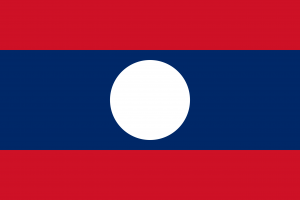Language/Lao/Grammar/Pronouns
Hi Lao learners! 😊
In this lesson, we will explore Lao Pronouns. Pronouns are crucial in communication as they help avoid repetition and assist in clarity.
After mastering this lesson, these related pages might interest you: Personal pronouns, Negation, Plurals & How to Use Have.
Lao Personal Pronouns[edit | edit source]
In Lao, personal pronouns are used in place of a noun that refers to a person or thing. Let's look at the Lao Personal pronouns in the table below:
| Lao | Pronunciation | English |
|---|---|---|
| ຂ້ານ | khăan | I/me |
| ທ່ານ | thaan | You |
| ເຂົ້າ | khăo(h) | He/him/it/she/her |
| ລາວ | láw | We/us |
| ທີ່ມ | thîi-mây | You all |
| ພວກເຮົາ | pheûak-hăo | They/them/ those |
Here are some examples in context:
- Person 1: ຂ້ານໄດ້ໃສ່ເຮົາແລ້ວ. (khăan dai săi hăo leu.) (I have told him.)
- Person 2: ຜູ້ນີ້ເຄີຍບໍ່ແມ່ນທ່ານຫລືບໍ່? (phûu nii kăe bò mâi mae thaan hǎr bò?) (Is this person yours or not?)
Lao Demonstrative Pronouns[edit | edit source]
Demonstrative pronouns in Lao are used to point out something or someone. They can also assist in avoiding repetition.
| Lao | Pronunciation | English |
|---|---|---|
| ນີ້ | nii | This (near) |
| ມີນີ້ | míi-nii | These (near) |
| ນີ້ໄດ້ | nii dai | This (far) |
| ມີນີ້ໄດ້ | míi-nii dai | These (far) |
| ນີ້ແມ່ນ | nii-mae | That (near) |
| ມີນີ້ແມ່ນ | míi-nii mae | Those (near) |
| ນີ້ໄດ້ແມ່ນ | nii dai-mae | That (far) |
| ມີນີ້ໄດ້ແມ່ນ | míi-nii dai-mae | Those (far) |
Let's see these examples below:
- Person 1: ມີນີ້ບໍ່ສໍາເລັດ. (míi-nii bò sǎm-lɛɛ.) (These are not useful.)
- Person 2: ສະບາຍດີທີ່ມ, ນີ້ແມ່ນຫຍັງ? (sà-baai-dii thîi-mây, nii-mae yang?) (Hello everyone, what is that?)
Lao Indefinite Pronouns[edit | edit source]
Indefinite pronouns refer to non-specific nouns. In Lao, they are used when referring to things or persons that are not identified.
| Lao | Pronunciation | English |
|---|---|---|
| ຫຼີ້ | lǔu | One/some |
| ຄົນຫວັງ | khon-wăng | Someone |
| ຫວ່າງວ່າງ | wăng-waang | Anybody |
Here are some examples in context:
- Person 1: ຫລັງຈະປະສົດຈາກນີ້ຫຼາຍບໍ? (lang jar pasot jḁ̀aj.ni̥.lua by nḁ̀ak pôn.) (How will we recover from this big mistake?)
- Person 2: ຫວ່າງວ່າງຂ້ອຍຮັກທີ່ເຮົາລອງ. (wăng-waang khǎo hûk thîi hǎo lǭng.) (Anybody can go wherever they want.)
Lao Interrogative Pronouns[edit | edit source]
Interrogative pronouns are used to ask questions. Here are the Lao Interrogative pronouns with their pronunciations and English translations:
| Lao | Pronunciation | English |
|---|---|---|
| ຈົດ | chót | Who |
| ຈົດຫວ່າງ | chót wăng | Anyone |
| ຄວາມ | khuaa(m) | What |
| ຈົດເທົ່າ | chót thĕuu | Whose |
| ຢຸດຢູ່ແມ່ນ | yùt-yùu mae | Where |
| ຈົດແມ່ນ | chót mae | Which |
Here are some examples in context:
- Person 1: ມີຄຳສັ່ງທີ່ເປັນຄຳຕອບແທກນັ້ນແລ້ວບໍ? (mîi kham sḁ̀engthîi pĕun khuaam-tôob thǎek nûan laew bò?) (What is the main instruction of this task?)
- Person 2: ຢຸດຢູ່ແມ່ນຕວາກທີ່ເຮົາຫລື? (yùt-yùu mae tuḁ̀ak thîi-hăo hǎr?) (Where are you going?)
Lao Reflexive Pronouns[edit | edit source]
Reflexive pronouns are used when the object of a sentence is the same as the subject. In Lao, reflexive pronouns are formed by adding the prefix "ຊອກ" (sok) before a personal pronoun. Let's see some reflexive pronouns in the table below:
| Lao | Pronunciation | English |
|---|---|---|
| ຕັນ | tan | Myself |
| ຕັ້ງ | tang | Yourself |
| ຕັກ | tak | Himself/herself/itself |
| ຕອບ | tḁ̀w | Ourselves |
| ທີ່ມຕັ້ງ | thîi-mây tang | Yourselves |
| ພວກເຮົາຕັກ | pheûak-hăo tak | Themselves |
Here are some examples in context:
- Person 1: ຂ້ານລອງເຈົ້າໄດ້ຮັກຕັກແລ້ວ. (khăan lǭng jĕuu dai hûk tak leu.) (I hurt myself)
- Person 2: ຮັກຕອບໂຫຼດໄຟ້ແລະເຂົ້າມາ. (hûk tḁ̀w hòolóa và khăo-maa.) (Let's download and install ourselves.)
Conclusion[edit | edit source]
Congratulations! You have learned about Lao pronouns. Practicing with native speakers is one of the most efficient strategies to improve your language skills. Polyglot Club is an online community where you can meet people from all over the world and improve your Lao language skills. Find native speakers and ask them any questions!
Don't forget that grammar is an important aspect of learning any language. You can also check our Grammar resource to improve your Lao language proficiency. Keep up the good work! 😊
➡ If you have any questions, please ask them in the comments section below.
➡ Feel free to edit this wiki page if you think it can be improved. 😎
Sources[edit | edit source]
Excellent job on conquering this lesson! Consider delving into these related pages: Adjectives, Say Hello and Greetings in Lao, How to Use Be & Demonstrative Pronouns.
Other Lessons[edit | edit source]
- Adjectives
- Give your Opinion
- Future Tense
- Personal pronouns
- Plurals
- Conditional Mood
- Demonstrative Pronouns
- Questions
- Negation

